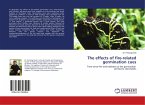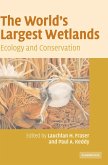Revision with unchanged content. Savannas cover around twenty percent of the world s land surface. With their vast extent, these areas - such as the famous Serengeti - not only provide an important environment for many plant and animal species, including human populations, but also display a wealth of natural beauty. Fire plays a key role in shaping these ecosystems. This is because the recurrent burning during the dry season not only destroys life, but also and importantly, enables new life to begin in a complex interplay. The increased frequency of fires resulting from global warming - either caused naturally or by human agency - is likely to affect this 'game of life' in a homogenizing negative way by reducing bio diversity or available grazing for livestock. However, besides this temporal component, fire has also a structural and spatial component that may be used as an active management tool to foster the well-being of life. For example, among successful biodiversity managers are the Australian Aboriginals with their traditionally practiced patch-burning strategy. Prior to the restricting fire policy of the modern country, they created a spatial mosaic of burnt grass patches in different successional stages, thereby enabling a diversity of animal life. This book summarizes the knowledge on fire structures including the geo metry and the area or the patchiness of burning.
Bitte wählen Sie Ihr Anliegen aus.
Rechnungen
Retourenschein anfordern
Bestellstatus
Storno








